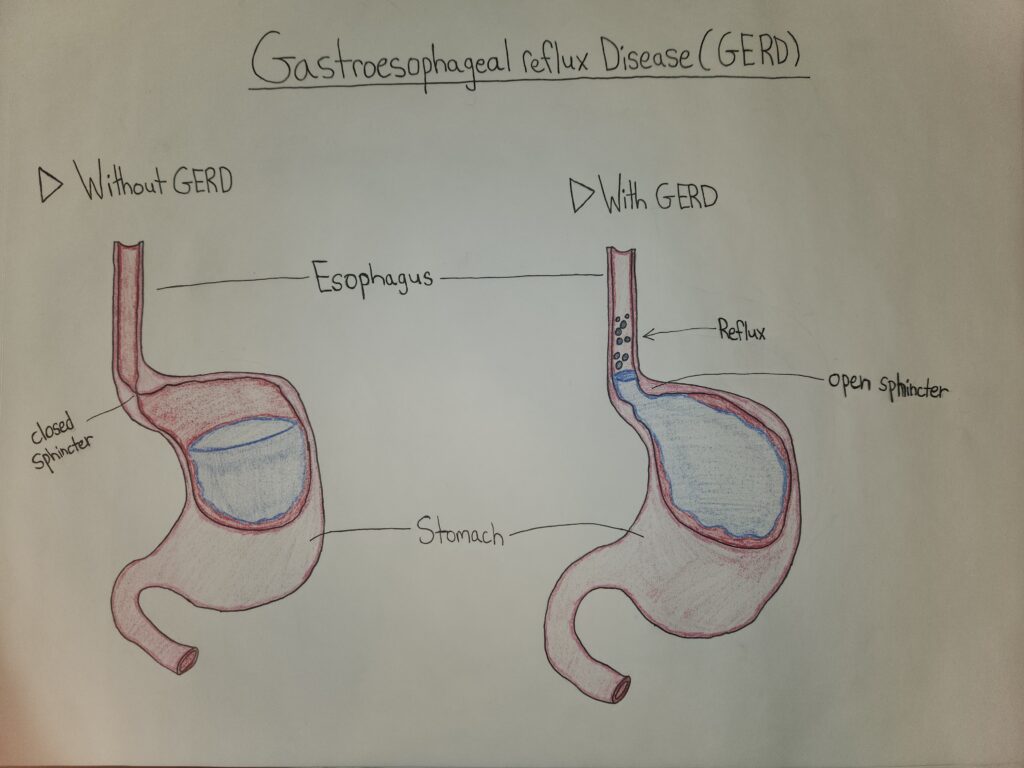I will be researching what GERD is and it effects on the body. This project aims to illustrate and describe GERD in relation to the digestive system. The course objective my STEAM project will relate to is the basic layers and functions of digestive organs.
The digestive system is a complex network of organs responsible for processing food and extracting nutrients essential for the body’s functions. Its primary functions include ingestion, the process of taking in food; mechanical breakdown, which involves the physical breakdown of food into smaller pieces; chemical digestion, the enzymatic breakdown of food molecules into absorbable nutrients; absorption, the process of transporting nutrients from the digestive tract into the bloodstream; and elimination, the removal of waste products from the body. The mouth is where digestion begins, and chewing breaks down food into smaller pieces. After this, food falls down the throat and into the esophagus. The esophagus moves the food into the stomach using peristalsis. Peristalsis is when adjacent segments of the alimentary canal, which includes organs like the esophagus, stomach, and intestines, undergo a rhythmic pattern of contraction and relaxation (Cleveland Clinic, 2022). Those actions are how we propel food through the body and digest it. Once in the stomach, food gets broken down further by gastric acid. This is where issues with GERD are caused.
The lower esophageal sphincter (LES) is located at the end of the esophagus, where it connects to the stomach. The esophagus is the tube that carries food and liquids from the mouth to the stomach, and it starts at the bottom of the throat. The LES acts as a valve that opens to allow food and liquids to enter the stomach and closes to prevent stomach contents from flowing back into the esophagus. In Gastroesophageal Reflux Disease (GERD), the lower esophageal sphincter (LES) weakens or relaxes incorrectly, allowing stomach acid and sometimes stomach contents to flow back up into the esophagus. This causes irritation and inflammation of the esophageal lining, leading to symptoms such as heartburn, chest pain, regurgitation, and sometimes difficulty swallowing (Clarrett & Hachem, 2018). The visual for this project will show the difference between a healthy stomach and one affected by GERD. The acid in the stomach that flows back into the esophagus is represented by the color blue.
According to the National Institute of Diabetes and Digestive and Kidney Diseases (2020), to treat gastroesophageal reflux (GER) or gastroesophageal reflux disease (GERD), doctors may recommend lifestyle changes, medications, or surgery. Lifestyle changes include losing weight to help alleviate pressure on the stomach, elevating your head during sleep, quitting smoking, and changing your eating habits. Medications for GERD include antacids (for mild symptoms), H2 blockers (to reduce stomach acid), and proton pump inhibitors (PPIs) (to lower stomach acid and heal the esophagus). Surgery is an option if lifestyle changes and medications don’t help with the most common one being fundoplication. During surgery, the surgeon wraps the top of your stomach around the bottom of your esophagus to make the lower esophageal sphincter tighter and reduce reflux. These treatments aim to reduce symptoms, heal the esophagus, and prevent complications.
In summary, Gastroesophageal Reflux Disease (GERD) is a condition where the lower esophageal sphincter (LES) weakens or relaxes incorrectly, allowing stomach acid and contents to flow back up into the esophagus, leading to irritation and inflammation of the esophageal lining. Through exploring the mechanism of GERD within the digestive system, it becomes evident that the lower esophageal sphincter (LES) plays a crucial role in ensuring the proper functioning of the digestive process.
Resources:
Cleveland Clinic. (2022, April 28). Peristalsis. Cleveland Clinic. https://my.clevelandclinic.org/health/body/22892-peristalsis
Clarrett, D. M., & Hachem, C. (2018). Gastroesophageal reflux disease (GERD). Missouri Medicine, 115(3), 214–218. https://www.ncbi.nlm.nih.gov/pmc/articles/PMC6140167/
National Institute of Diabetes and Digestive and Kidney Diseases. (2020, July). Acid reflux (GER and GERD) in adults. NIH: National Institute of Diabetes and Digestive and Kidney Diseases. https://www.niddk.nih.gov/health-information/digestive-diseases/acid-reflux-ger-gerd-adults/definition-facts
Bumrungrad International Hospital. (2021, November). Transoral incisionless fundoplication. Bumrungrad Health Blog. https://www.bumrungrad.com/en/health-blog/November-2021/transoral-incisionless-fundoplication


Hello Sean! I enjoyed reading about and viewing your project. You made it very easy to understand what GERD is and how it impacts the digestive system. You also talked about the different solutions to GERD, for mild to more extreme cases. I found in particular the surgery option interesting, as I did not know it was an option to begin with. It makes sense, since the sphincter needs to be strengthened to work properly. The art aspect of your work was also very easy to understand. Great job!